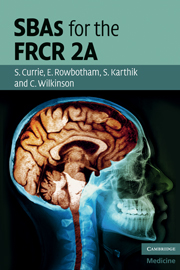Book contents
- Frontmatter
- Contents
- List of contributors
- Preface
- Introduction
- Module 1 Cardiothoracic and vascular
- Module 2 Musculoskeletal and trauma
- Module 3 Gastro-intestinal
- Module 4 Genito-urinary, adrenal, obstetrics & gynaecology and breast
- Module 5 Paediatric
- Module 6 Central nervous and head & neck
- Questions
- Answers
- References
- Index
Answers
Published online by Cambridge University Press: 06 July 2010
- Frontmatter
- Contents
- List of contributors
- Preface
- Introduction
- Module 1 Cardiothoracic and vascular
- Module 2 Musculoskeletal and trauma
- Module 3 Gastro-intestinal
- Module 4 Genito-urinary, adrenal, obstetrics & gynaecology and breast
- Module 5 Paediatric
- Module 6 Central nervous and head & neck
- Questions
- Answers
- References
- Index
Summary
1. a. Germinoma
Germinomas are germ-cell tumours arising from primordial germ cells. They frequently occur in the midline, mostly in the pineal region but also in the suprasellar region.
In men, 80% of pineal masses are germ-cell tumours, in contrast to 50% in women. They tend to occur in children or young adults (10–25 years old). Symptoms depend on the location but the case describes Parinaud syndrome – paralysis of upward gaze due to compression of the mesencephalic tectum. Germinomas may also cause hydrocephalus by compression of the aqueduct of Sylvius, thus patients may present with signs and symptoms of raised intracranial pressure. Germinomas are a known cause of precocious puberty in children under the age of ten years. They are malignant tumours and may show CSF seeding, making cytological diagnosis possible with lumbar puncture. They are, however, very radiosensitive and show excellent survival rates.
Pineal teratomas tend to be heterogeneous masses containing fat and calcifications. Pineoblastoma is a highly malignant tumour which is more common in children and usually has poor tumour margins.
(Refs: Dahnert p. 321; Sutton p. 1748)
2. d. Meningioma
It is rare for meningiomas to occur intraventricularly (2–5% of all meningiomas) but they are the most common trigonal intraventricular mass in adulthood. They tend to occur in 40 year old females.
(Ref: Dahnert p. 306)
3. e. Pituitary adenoma
Pituitary adenomas are divided into microadenomas (<1 cm) and macroadenomas (>1 cm). Macroadenomas may present with endocrine dysfunction but are generally less active than microadenomas.
- Type
- Chapter
- Information
- SBAs for the FRCR 2A , pp. 141 - 156Publisher: Cambridge University PressPrint publication year: 2010



